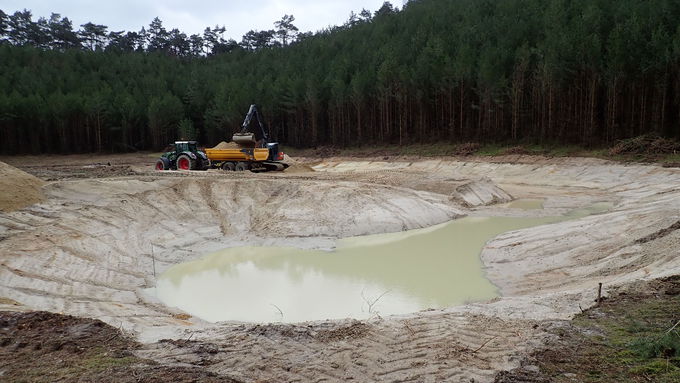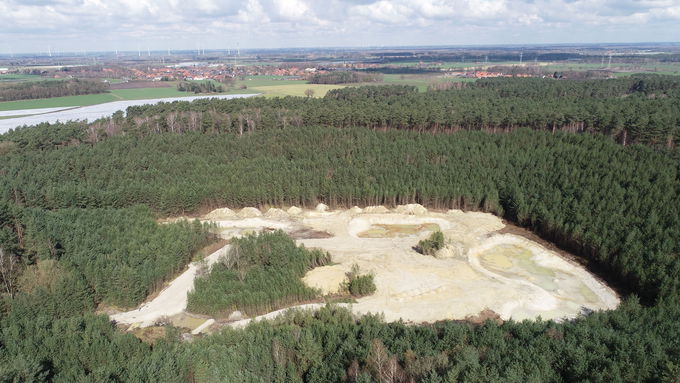Dredging of a spawning water for the natterjack toad (Bufo calamita) with shaped shallow water areas. © Thomas Kutter, NLWKN
main content
Project of the month
#06/2020 UPGRADING OF A FORMER SANDPIT NEAR KIRCHDORF
Haven of well-being for the natterjack toad
About 1.5 kilometres south of the village of Kirchdorf in the district of Diepholz, there is a former sand pit hidden in a woodland. Since the end of the mining activities, woody plants had reclaimed the pit. Previously existing small waterbodies were only in a rudimentary state and moreover heavily shaded. Nevertheless, the area was basically classified as very important for the natterjack toad (Bufo calamita) and it has a wide potential as habitat. Occurrences of the toad species are known from the immediate vicinity. In order to improve the habitat and reproduction conditions for this pioneer species in the sandpit, at the beginning of 2020, measures were implemented within the framework of LIFE IP Atlantic Region DE. The overall objective was to stabilize the local population of natterjack toad and improve its conservation status. On site, the action was supervised by the "Stiftung Naturschutz im Landkreis Diepholz" (= Foundation for Nature Conservation in the District of Diepholz).
The municipality of Kirchdorf, as the owner of the area, agreed to the project. First of all, a map based on a laser scan survey from 2017 was drawn up in order to be able to plan the measures precisely on the basis of the local topography. The core elements of the upgrading were to be an area-wide removal of woody plants and the creation of spawning waters. In order to be able to make statements on the water retention, hydrogeological studies were carried out first. These showed that there are no water-storing layers in the ground and that only in some places fine surface sediments from the time of sand mining provide small puddles. A groundwater supply of the waterbodies was considered important in order to enable a safe water regimen.
The first step was to cut, chop and remove the woody plants on an area of 1.2 hectares. Root stumps were removed and deposited in heaps at the edge of the area as partial habitat. The second step consisted of dredging the small waterbodies with scraping of the groundwater level. The water bodies were shaped with shallow water areas and different depths. The structural diversity as well as the zoning should counteract a simultaneous drying-up of all waters and the settlement of predators of tadpoles (such as fish). A total area of over 2,000 square metres was created. The excavated material was distributed within the mining area by means of excavators and tractors with dumpers. Most of the sand is now leveled in the sand pit, but there are also heaps. The heaps were partly compressed, but mainly loosely piled up. Two "steep faces" may serve as breeding grounds for wild bees and other sand-bound insects. A short sightseeing flight over the area with the newly created waterbodies can be found at https://www.youtube.com/watch?v=flQi3jatQAY.
In the second vegetation period after implementation of the action, the first monitoring is to be initiated by the NLWKN's statewide nature conservation department. The Foundation for Nature Conservation in the District of Diepholz has accepted the sandpit as project area and plans to carry out a two-year monitoring in cooperation with the ‘BUND Diepholzer Moorniederung’. This will then also include the implementation of necessary maintenance measures.
In the end, the action has created an ideal habitat for the natterjack toad with sunlit small waterbodies which hopefully will be adopted by many individuals in the coming years. The first successes were already visible in June 2020: In many of the newly created waterbodies, offspring of the natterjack toad could be detected. The reproduction of the target species so immediately after the implementation of the measures had not been expected either by the ‘Stiftung Naturschutz im Landkreis Diepholz’ or by the LIFE IP team.





